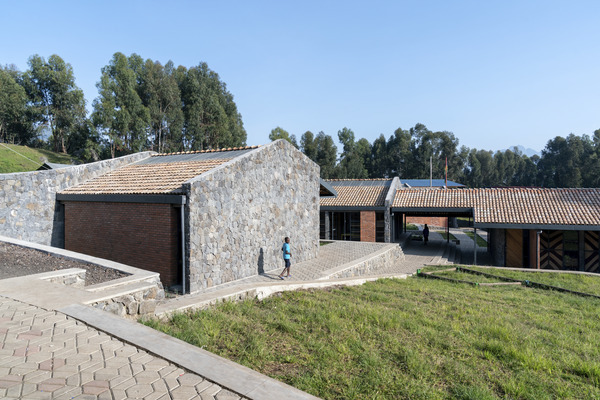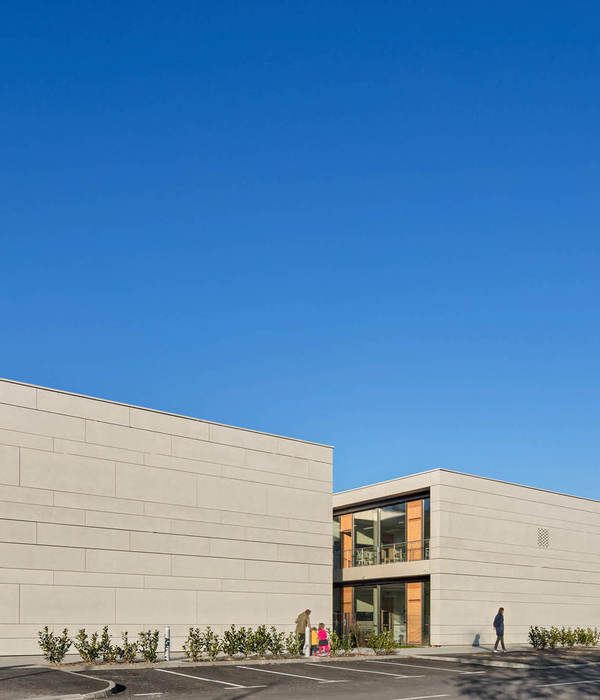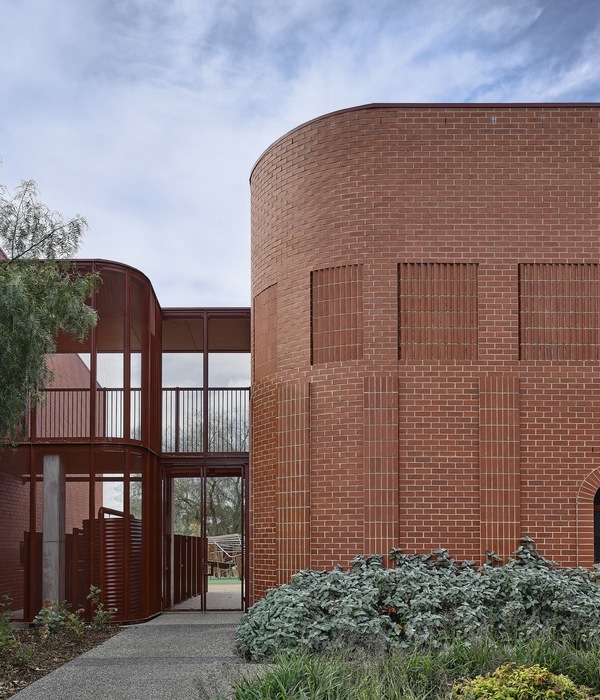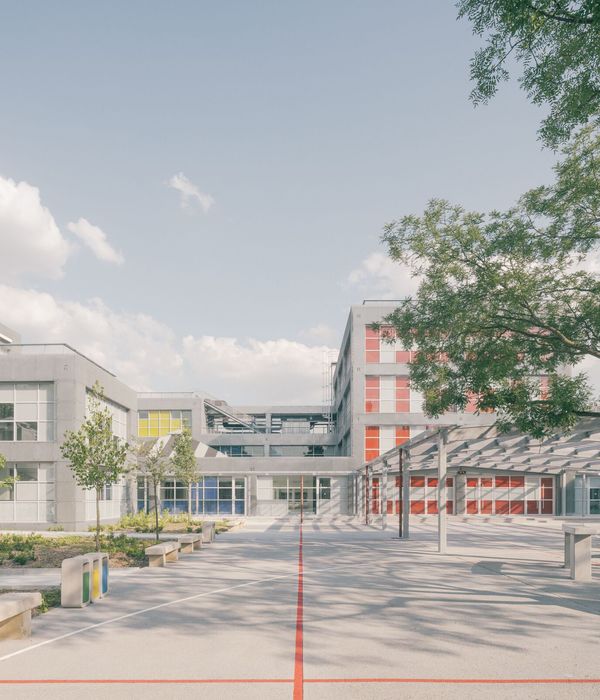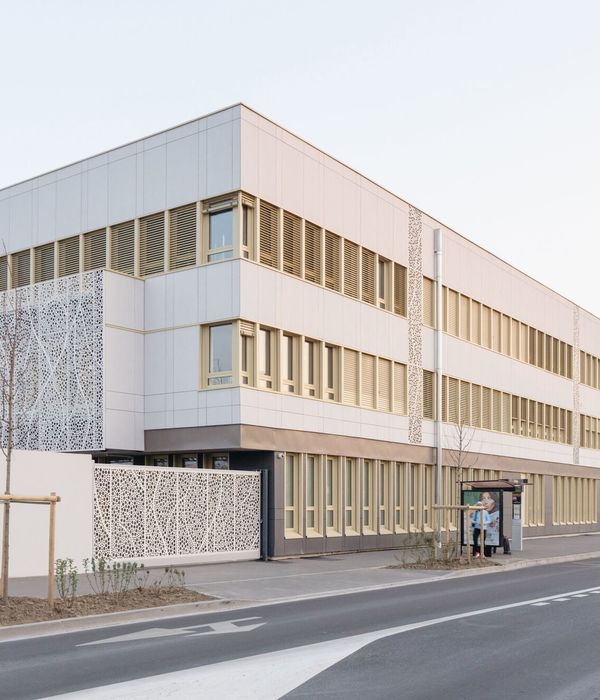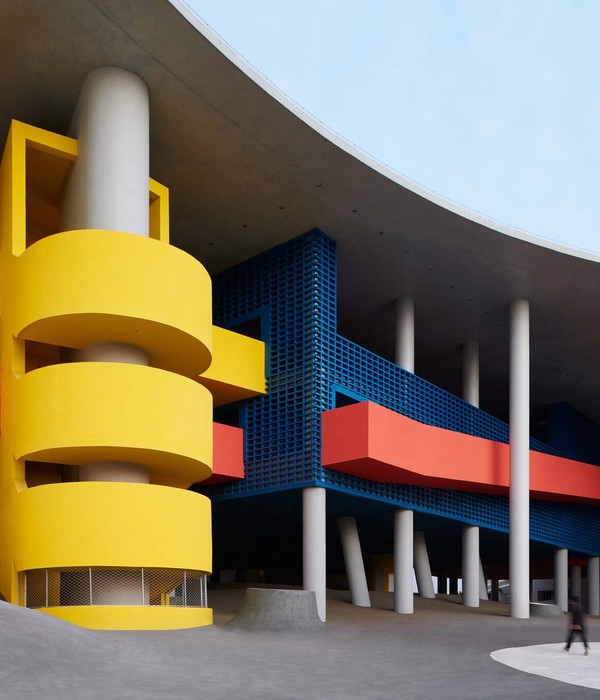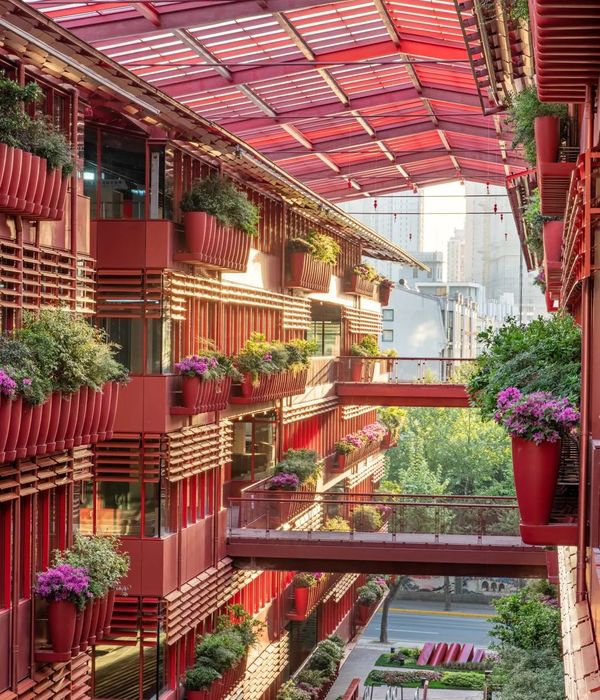Courtesy of Zaha Hadid Architects
扎哈·哈迪德建筑师的礼遇
自1926年第一次建造以来,滑雪跳台一直是柏吉塞尔山顶上的固定项目。这里已经举办了两届冬季奥运会-第一次是在1964年,第二次是在1976年。即使在奥运场馆之外,该设施也经常被使用;事实上,日程安排非常拥挤,以至于地方市政当局只能批准从拆除旧建筑到新建筑开放之间的一年时间。
The Ski Jump has been a fixture atop Bergisel Mountain since its first construction in 1926. It has been the home to two Winter Olympics competitions – first in 1964, and then again in 1976. Even outside its service as an Olympic venue, the facility saw constant use; scheduling was so densely booked, in fact, that the local city authorities could only authorize one year between the demolition of the old structure and the opening of the new.[1]
The Ski Jump has been a fixture atop Bergisel Mountain since its first construction in 1926. It has been the home to two Winter Olympics competitions – first in 1964, and then again in 1976. Even outside its service as an Olympic venue, the facility saw constant use; scheduling was so densely booked, in fact, that the local city authorities could only authorize one year between the demolition of the old structure and the opening of the new.[1]
1999年,因斯布鲁克开始了一个整修老化的奥林匹克竞技场的项目。不幸的是,由于原来的滑雪跳台设施已不再符合当代国际标准,人们认为有必要建造一个替代设施。新的Bergisel Ski Jump将提供比其前身更多的功能:除了专门的体育项目外,该设施还将包括新的公共空间,包括一个观景平台和一家咖啡馆。[2]除了这些规划要求之外,奥地利滑雪联合会显然寻求创造出不仅仅是一项体育基础设施。他们在呼吁建造一座新的纪念碑。
In 1999, Innsbruck began a project to refurbish its aging Olympic Arena. Unfortunately, as the original ski jump facility no longer conformed to contemporary international standards, it was deemed necessary to build a replacement. The new Bergisel Ski Jump was to provide a greater variety of functions than its predecessor: alongside the specialized sports program, the facility was to include new public spaces, comprising a viewing terrace and a café.[2] Beyond these programmatic requirements, the Austrian Ski Federation evidently sought to create more than a piece of athletic infrastructure. They were calling for a new monument.[3]
In 1999, Innsbruck began a project to refurbish its aging Olympic Arena. Unfortunately, as the original ski jump facility no longer conformed to contemporary international standards, it was deemed necessary to build a replacement. The new Bergisel Ski Jump was to provide a greater variety of functions than its predecessor: alongside the specialized sports program, the facility was to include new public spaces, comprising a viewing terrace and a café.[2] Beyond these programmatic requirements, the Austrian Ski Federation evidently sought to create more than a piece of athletic infrastructure. They were calling for a new monument.[3]
Courtesy of Zaha Hadid Architects
扎哈·哈迪德建筑师的礼遇
考虑到这些规格,奥地利滑雪联合会于1999年主办了一次新滑雪跳台的国际设计竞赛,同年12月,扎哈·哈迪德建筑师在比赛中获得一等奖。4哈迪德的建议是巨大的,长90米,比贝吉塞尔山高出近50米。尽管它的大小,但是,滑雪跳跃的设计是为了与山无缝融合:各种程序要求被塑造成一个单一的,最小的质量,与滑雪坡道继续山坡向上向天空。
With these specifications in mind, the Austrian Ski Federation hosted an international design competition for the new ski jump in 1999, and Zaha Hadid Architects were awarded the first prize in the competition in December of the same year.[4] Hadid’s proposal was massive, measuring 90 meters long and towering almost 50 meters over the peak of Bergisel Mountain. Despite its size, however, the Ski Jump was designed to blend seamlessly with the mountain: the various program requirements were molded into a single, minimal mass, with the ski ramp continuing the slope of the mountainside up toward the sky.[5]
With these specifications in mind, the Austrian Ski Federation hosted an international design competition for the new ski jump in 1999, and Zaha Hadid Architects were awarded the first prize in the competition in December of the same year.[4] Hadid’s proposal was massive, measuring 90 meters long and towering almost 50 meters over the peak of Bergisel Mountain. Despite its size, however, the Ski Jump was designed to blend seamlessly with the mountain: the various program requirements were molded into a single, minimal mass, with the ski ramp continuing the slope of the mountainside up toward the sky.[5]
Courtesy of Zaha Hadid Architects
扎哈·哈迪德建筑师的礼遇
哈迪德把她的设计描述为一座塔和一座桥之间的“有机混合体”。[6]这座塔是一条高大的混凝土竖井,平面上形成了一个7米长的方形。[7]两部电梯将游客从塔底运送到位于山顶上方40米的咖啡馆。咖啡厅是塔顶更大空间的一部分,它将公共空间和滑雪坡道融合成一个视觉上有凝聚力的整体。[8]观景台提供了一个全方位的不间断景观,让游客可以从一个单独的空间观察Innsbruck市中心和周围的阿尔卑斯山。
Hadid described her design as an “organic hybrid” between a tower and a bridge.[6] The tower is a tall concrete shaft, forming a seven-meter square in plan.[7] Two elevators ferry visitors from the base of the tower to the café, which is situated 40 meters over the peak of the mountain. The café is part of the larger spatial volume perched atop the tower, which fuses the public spaces and the ski ramp into a visually cohesive whole.[8] The observation deck provides an uninterrupted view in every direction, allowing visitors to survey both downtown Innsbruck and the surrounding Alps, from a single space.[9]
Hadid described her design as an “organic hybrid” between a tower and a bridge.[6] The tower is a tall concrete shaft, forming a seven-meter square in plan.[7] Two elevators ferry visitors from the base of the tower to the café, which is situated 40 meters over the peak of the mountain. The café is part of the larger spatial volume perched atop the tower, which fuses the public spaces and the ski ramp into a visually cohesive whole.[8] The observation deck provides an uninterrupted view in every direction, allowing visitors to survey both downtown Innsbruck and the surrounding Alps, from a single space.[9]
滑雪跳远的不同部件作为一个单一的无缝、不间断的质量的表达并不是由程序决定的,也不是纯粹为了直观地证实塔台和桥梁的杂交。滑雪跳台是速度非常快,甚至是飞行的地方。正是这种运动精神构成了哈迪德设计的流线型,体现了运动的动态性。
The articulation of the Ski Jump’s different components as a single seamless, uninterrupted mass was not dictated by the program; nor was it purely intended as a visual confirmation of the hybridization of a tower and a bridge. A ski jump is the site of extraordinary speed and even flight. It is this spirit of motion that informs the flowing form of Hadid’s design, which embodies the dynamic nature of the sport it was built to facilitate.[10]
The articulation of the Ski Jump’s different components as a single seamless, uninterrupted mass was not dictated by the program; nor was it purely intended as a visual confirmation of the hybridization of a tower and a bridge. A ski jump is the site of extraordinary speed and even flight. It is this spirit of motion that informs the flowing form of Hadid’s design, which embodies the dynamic nature of the sport it was built to facilitate.[10]
不幸的是,尽管哈迪德的极简主义设计抓住了运动的精神,但它并没有被普遍接受。一些当地人拒绝了让一座毫不掩饰的现代化建筑笼罩着他们的城镇的想法;因斯布鲁克在很大程度上是一座传统的阿尔卑斯山城市。
Unfortunately, while Hadid’s minimalist design captured the spirit of motion, it was not universally accepted. Some locals rejected the notion of having an unabashedly modern building looming over their town; Innsbruck was, for the most part, an emphatically traditional alpine city.[11]
Unfortunately, while Hadid’s minimalist design captured the spirit of motion, it was not universally accepted. Some locals rejected the notion of having an unabashedly modern building looming over their town; Innsbruck was, for the most part, an emphatically traditional alpine city.[11]
在因斯布鲁克,人们对哈迪德的提议感到不安可能是意料之中的。因斯布鲁克的街道两旁排列着可以追溯到城市丰富的中世纪起源的建筑。从1420年起,奥地利蒂罗尔公爵领地的首府,因斯布鲁克的历史遗迹随处可见。这座城市大多数最突出的地标建筑,如Fürstenburg大楼,已经存在了几个世纪了-引入了一座混凝土和玻璃塔,俯瞰着中世纪历史上的因斯布鲁克尖塔,被一些人认为是不协调的。
The unease surrounding Hadid’s proposal was perhaps to be expected in Innsbruck, whose streets are lined with buildings dating back to the city’s rich medieval origins. The capital of the Austrian duchy of Tyrol since 1420, Innsbruck is peppered with monuments to its history. Most of the city’s most prominent landmarks, such as the Fürstenburg building, have existed for centuries – to introduce introduce a tower of concrete and glass overlooking the medieval spires of historic Innsbruck was seen by some as incongruous.[12]
The unease surrounding Hadid’s proposal was perhaps to be expected in Innsbruck, whose streets are lined with buildings dating back to the city’s rich medieval origins. The capital of the Austrian duchy of Tyrol since 1420, Innsbruck is peppered with monuments to its history. Most of the city’s most prominent landmarks, such as the Fürstenburg building, have existed for centuries – to introduce introduce a tower of concrete and glass overlooking the medieval spires of historic Innsbruck was seen by some as incongruous.[12]
© Helene Binet
海琳·比内
尽管遭到反对,建筑仍按计划进行,新的Bergisel Ski Jump于2002年向公众开放。和它的前身一样,这座新设施成为了不断活动的场所:它是每年1月举行的四山锦标赛的第三站,而夏季则会看到许多世界知名的滑雪运动员来到贝吉塞尔训练-有些是为了奥运会。其他游客可以从观景台上欣赏到风景,无论他们是选择观看运动员在下面滑雪,还是简单地观察周围的高山山腰。
Despite opposition, construction proceeded on schedule and the new Bergisel Ski Jump opened to the public in 2002. Like its predecessor, the new facility became the locus for constant activity: it is the third site of the Four Hills Tournament every January, while the summers see many world-renowned ski jumpers come to Bergisel to train – some for the Olympics. Other visitors can simply enjoy the view from the observation deck, whether they choose to watch the athletes skiing below or simply survey the surrounding alpine mountainsides.[13]
Despite opposition, construction proceeded on schedule and the new Bergisel Ski Jump opened to the public in 2002. Like its predecessor, the new facility became the locus for constant activity: it is the third site of the Four Hills Tournament every January, while the summers see many world-renowned ski jumpers come to Bergisel to train – some for the Olympics. Other visitors can simply enjoy the view from the observation deck, whether they choose to watch the athletes skiing below or simply survey the surrounding alpine mountainsides.[13]
Courtesy of Zaha Hadid Architects
扎哈·哈迪德建筑师的礼遇
参考文献[1]。扎哈·哈迪德:1979-2009年全集。Köln:Taschen,2009年。p 159。[2]没有人,彼得,编辑。Zaha Hadid Architektur.维也纳:Hatje坎茨·韦拉格,2003年。第119页。[3]Jodidio,p 159。[4]任何人,第119页。[5]Papadakis,Alexandra,ed。扎哈·哈迪德。伦敦:新建筑集团有限公司,2005年。p 145。[6]“Bergisel Ski Jump.”扎哈·哈迪德建筑师。2016年4月25日[7]Jodidio,p 159。[8]“Bergisel Ski Jump.”[9]“Bergisel Ski Jump.”奥地利。2016年4月27日[10]任何人,p 159-160。[11]任何人,第159页。[12]大英百科全书在线网。v.“Innsbruck”,2016年4月27日。[13]“Bergisel Ski Jump Innsbruck.”蒂罗尔。2016年4月27日[进入]
References [1] Jodidio, Philip. Zaha Hadid: Hadid: Complete Works 1979-2009. Köln: Taschen, 2009. p159. [2] Noever, Peter, ed. Zaha Hadid Architektur. Vienna: Hatje Cantz Verlag, 2003. p119. [3] Jodidio, p159. [4] Noever, p119. [5] Papadakis, Alexandra, ed. Zaha Hadid. London: New Architecture Group Limited, 2005. p145. [6] "Bergisel Ski Jump." Zaha Hadid Architects. Accessed April 25, 2016. [access] [7] Jodidio, p159. [8] "Bergisel Ski Jump." [9] "Bergisel Ski Jump." Austria. Accessed April 27, 2016. [access] [10] Noever, p159-160. [11] Noever, p159. [12] Encyclopædia Britannica Online, s. v. "Innsbruck", accessed April 27, 2016. [access] [13] "Bergisel Ski Jump Innsbruck." Tirol. Accessed April 27, 2016. [access]
References [1] Jodidio, Philip. Zaha Hadid: Hadid: Complete Works 1979-2009. Köln: Taschen, 2009. p159. [2] Noever, Peter, ed. Zaha Hadid Architektur. Vienna: Hatje Cantz Verlag, 2003. p119. [3] Jodidio, p159. [4] Noever, p119. [5] Papadakis, Alexandra, ed. Zaha Hadid. London: New Architecture Group Limited, 2005. p145. [6] "Bergisel Ski Jump." Zaha Hadid Architects. Accessed April 25, 2016. [access] [7] Jodidio, p159. [8] "Bergisel Ski Jump." [9] "Bergisel Ski Jump." Austria. Accessed April 27, 2016. [access] [10] Noever, p159-160. [11] Noever, p159. [12] Encyclopædia Britannica Online, s. v. "Innsbruck", accessed April 27, 2016. [access] [13] "Bergisel Ski Jump Innsbruck." Tirol. Accessed April 27, 2016. [access]
建筑师扎哈哈迪德建筑师位置Bergiselweg 3,6020因斯布鲁克,奥地利建筑师负责扎哈哈迪德地区91.0平方米项目年2002照片海琳比内,詹姆斯泰勒-福斯特类滑雪中心制造商装载.
Architects Zaha Hadid Architects Location Bergiselweg 3, 6020 Innsbruck, Austria Architect in Charge Zaha Hadid Area 91.0 m2 Project Year 2002 Photographs Helene Binet, James Taylor-Foster Category Ski Center Manufacturers Loading...
Architects Zaha Hadid Architects Location Bergiselweg 3, 6020 Innsbruck, Austria Architect in Charge Zaha Hadid Area 91.0 m2 Project Year 2002 Photographs Helene Binet, James Taylor-Foster Category Ski Center Manufacturers Loading...
{{item.text_origin}}



